After the fascinating tactical battle that was the first leg of this Champions League semi-final at Tottenham Hotspur’s new stadium, we know a lot more about what we might expect from the two sides going into the second leg.
Tottenham will be heading to the Johan Cruyff Arena knowing that they must score if they are to have any chance of progressing, though if they do get off the mark then the away goals rule could come into play in their favour.
This tactical preview will assess how both teams might approach the tie and highlight some of the tactical battles to look out for in Wednesday’s big game.
Tottenham’s different options in attack
In the first leg, Mauricio Pochettino opted to play with two up front, as he has done for a lot of this season. Though with Harry Kane, Heung-Min Son and Vincent Janssen unavailable he had no option but to partner Fernando Llorente up top with Lucas Moura.
For the second leg, however, Pochettino will have Heung-Min Son available once more, and the South Korean’s positional flexibility means that he could either be used to partner one of Llorente or Moura in attack, or cut in from the left wing in a 4-2-3-1 formation as he did in Saturday’s game against Bournemouth.
Pochettino’s possible formations
One tactical set-up we can probably rule out is the 5-3-2 formation used for the first 21 minutes against Ajax in which Spurs found themselves overrun in midfield. Pochettino changed this by bringing Danny Rose into midfield as he switched to a back four when he saw it was not working. He has since admitted to his mistake in an interview with BT Sport:
“Watching now of course I can accept it was a mistake the shape we used…”
What sort of shape can we then expect from the Argentinian coach? This season his two favoured formations have been the 4-2-3-1 and the 4-3-1-2, also known as the 4-4-2 diamond. We should expect Spurs to start with one of these two formations, though with the flexibility of players like Son, Pochettino could easily change the shape mid-game as he is known to do.
The 4-2-3-1
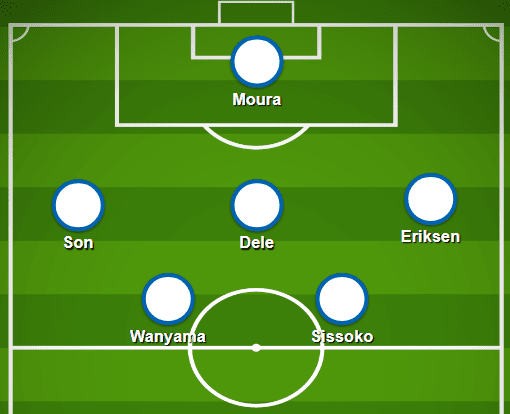
This is the set-up Pochettino went with in Sunday’s defeat to Bournemouth. If they were to play this way again then they would mirror Ajax’s system. One of the potential benefits of playing this way is that the double pivot of Wanyama or Dier with Sissoko would allow them to better cope with the threat posed by both Dušan Tadić and Donny van de Beek operating in the spaces between the lines. In addition to this, the wide attacking players would be able to get back and offer protection to the full-backs in defensive phases.
However, when Spurs are in possession they tend to play very narrow with the wide players drifting inside. In the image below from the Bournemouth game, playmaker Christian Eriksen drifts over to the left to create an overload, much in the same way as Hakim Ziyech (who plays the same role for Ajax) did in the first leg when he set up Ajax’s goal.
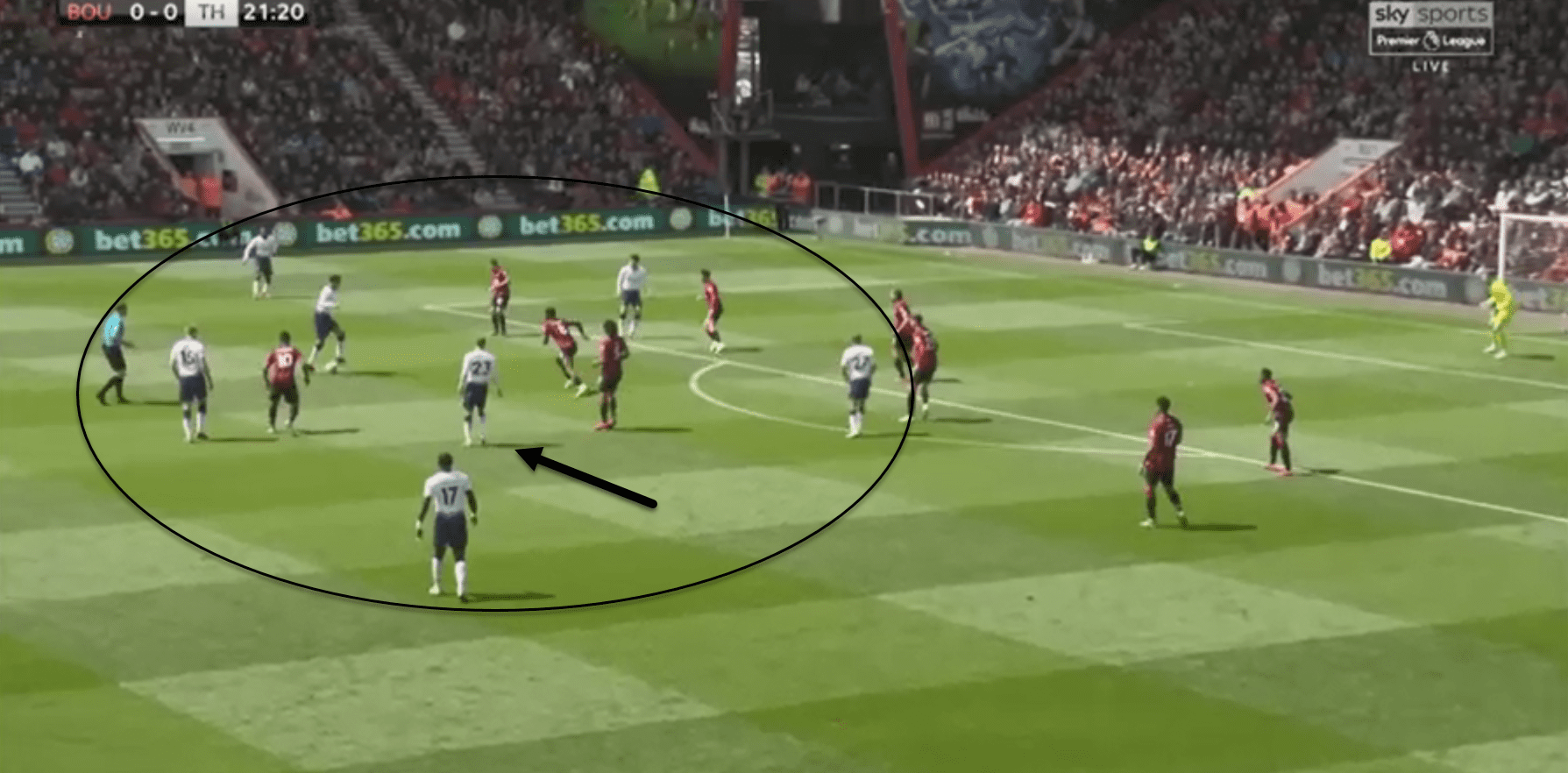
But one major difference between the two sides when they play this system is that in Moussa Sissoko Tottenham have a potential runner from central midfield. The Frenchman is not afraid to bomb forward and be the extra man in attacks, especially down the right-hand side where he can link up with Trippier and Eriksen.
As can be seen in the image below, Sissoko adds unpredictability and dynamism to Tottenham’s attack with his sudden bursts forward into space. This complements the talents of Spurs’ more technical players such as Eriksen who tends to create a lot of space for others simply by attracting defenders’ attention when they have the ball.
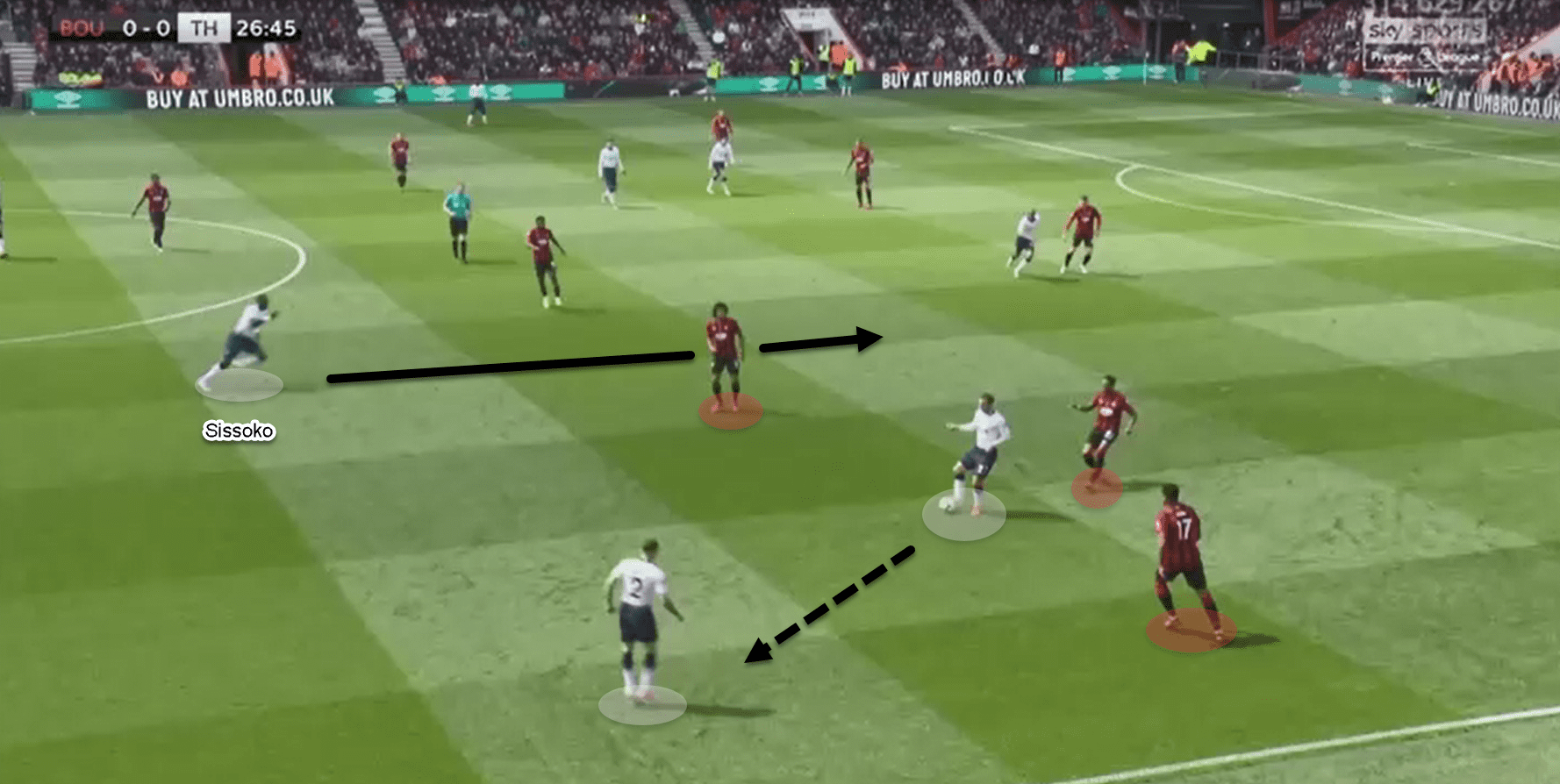
These kinds of runs could cause problems for Ajax, and Spurs are going to need Sissoko to do this if their attacking play becomes slow and predictable.
The 4-3-1-2
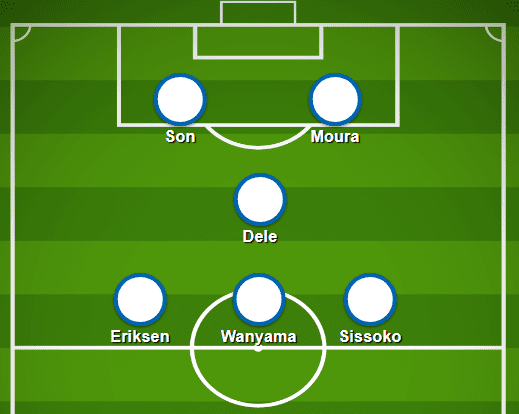
This is the shape that Pochettino reverted to in the 21st minute of the first leg when he saw his team were in trouble. As can be seen below, by moving Rose into midfield Spurs had more numbers centrally, whilst Dele Alli could link the midfield and attack.
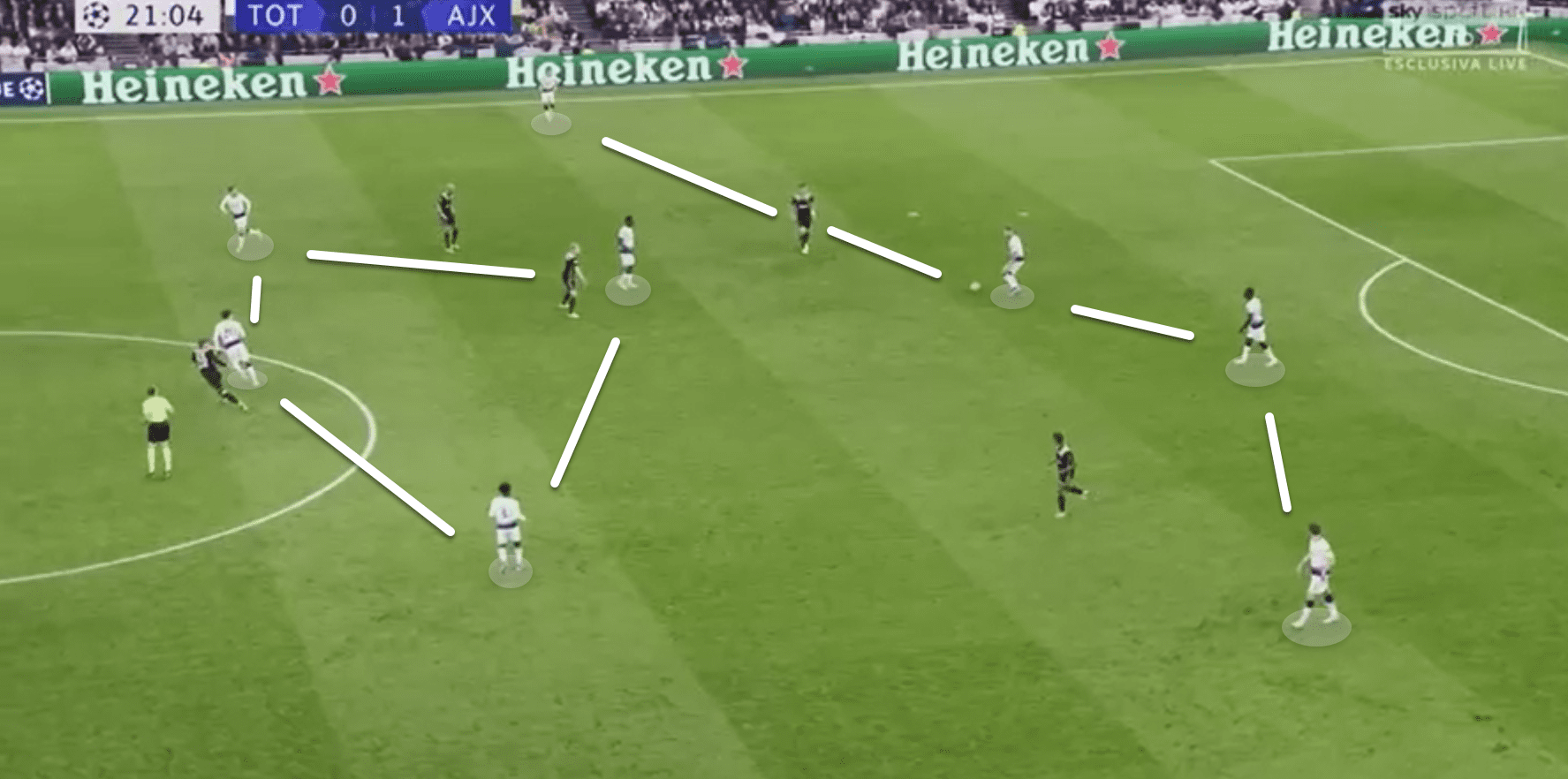
Pochettino is known for changing his system mid-game and to switch between the 4-2-3-1 and the 4-3-1-2 will be very straightforward since the players are comfortable in both systems and no substitutions will be necessary.
When playing in this system Tottenham are somewhat more direct and especially dangerous on the counter attack considering the pace of players like Son and Moura. One weakness of the system though is its narrowness as it is difficult for the midfielders to effectively protect the flanks.
When Ajax are in possession they will be aware of how they can hurt Spurs by quickly switching play to the flanks. This is what they did in the image below, where Ziyech managed to pick out left-back Nicolás Tagliafico in space in what led to a very dangerous chance for the away side.
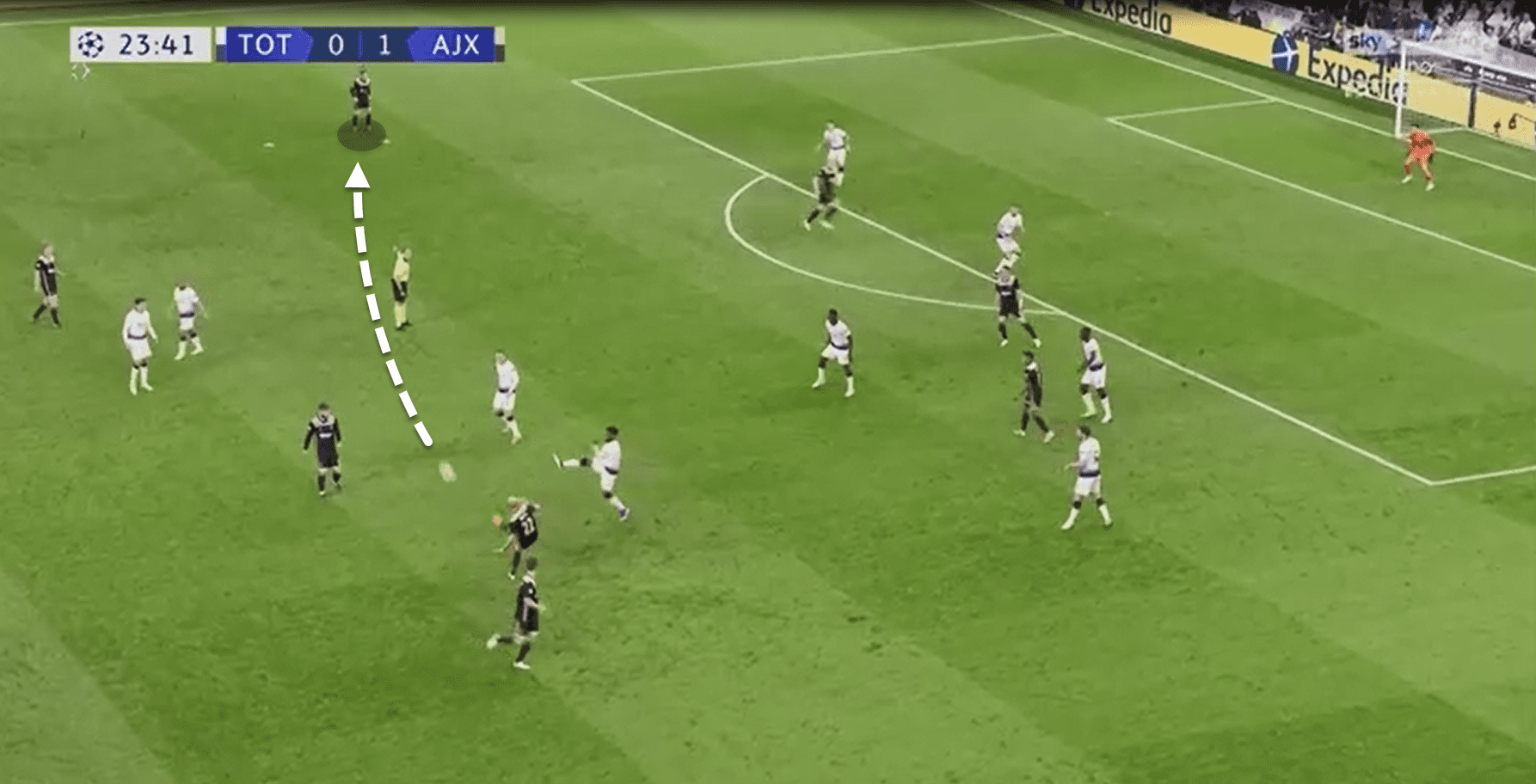
On the positive side for Pochettino’s team, the narrowness of the system can also be used to their advantage to create space for the full-backs to run into. But this will depend on the full-backs providing much better delivery than they did in the first leg.
In the image below Danny Rose received the ball from Dele Alli with plenty of space and time yet delivered a weak cross that was easily cleared by the Ajax back line.
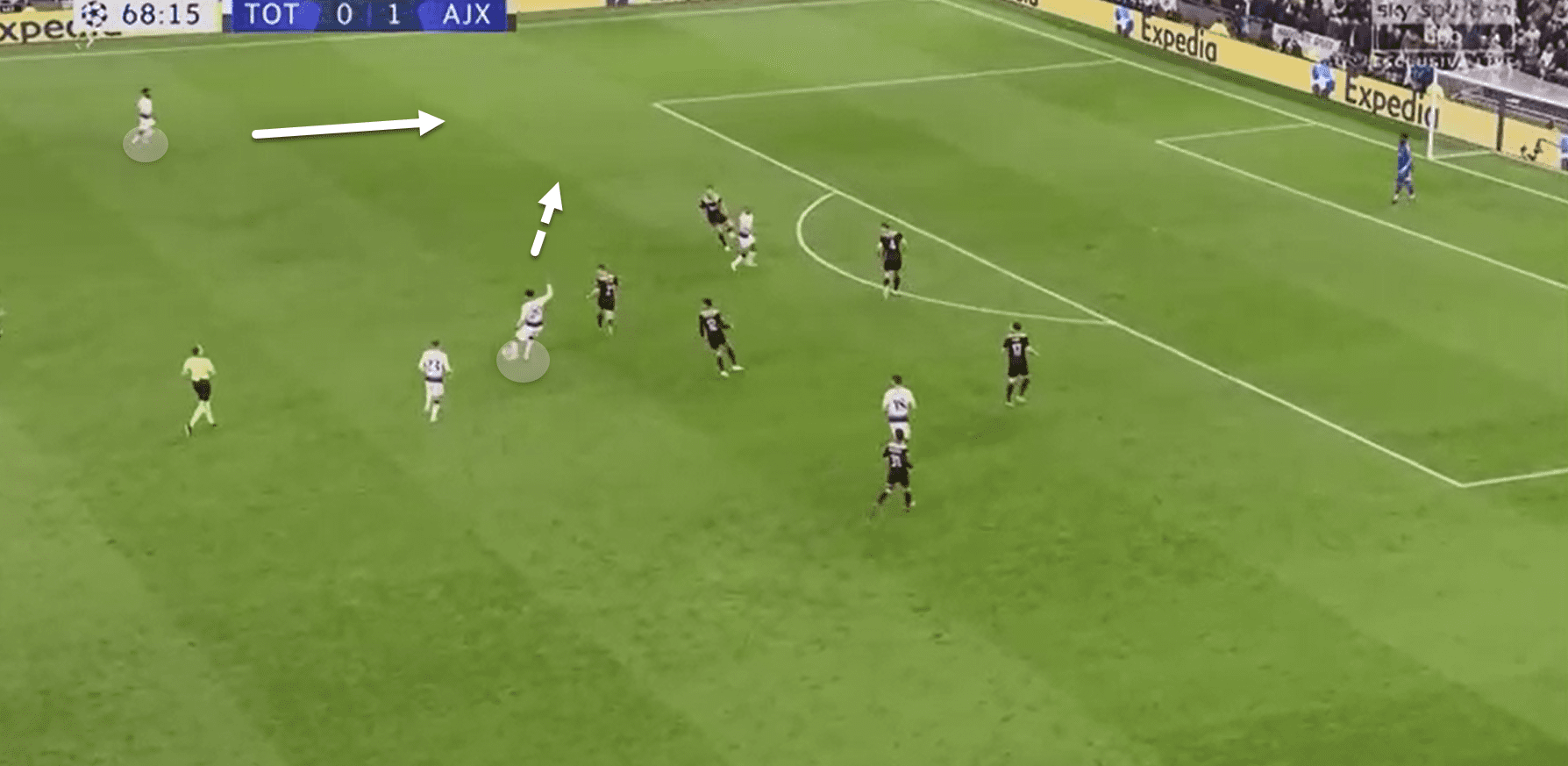
Crossing is a big part of Tottenham’s game but in this match more than ever they need to make sure that the crosses count. Many of Trippier’s crosses in the first leg were targeted at Fernando Llorente and Dele Alli at the far post, but in this area Ajax had Matthijs de Ligt and Joël Veltman, both of whom can hold their own in an aerial battle.
The one Ajax defender who could be vulnerable in the air is left-back Nicolás Tagliafico. At only 5’ 8” tall, the Argentinian is no match for the likes of Dele Alli or Fernando Llorente in the air. But to target him effectively Tottenham will have to provide good quality crosses from the left-hand side of the pitch.
Fernando Llorente
At some stage of the game, there is a good chance that Pochettino will turn to his target man, Fernando Llorente. When the Spaniard plays, Tottenham’s style becomes a lot more direct and as Harry Kane has been injured for large parts of the season, the lilywhites have gradually learnt how to best play to his strengths.
Playing to Llorente’s strengths means playing the ball to him where he can receive it with his back to goal and knock it on for onrushing teammates. This tactic works best when Llorente plays in a two with a number 10 like Dele Alli making runs from behind him, as in the image below from the first leg.
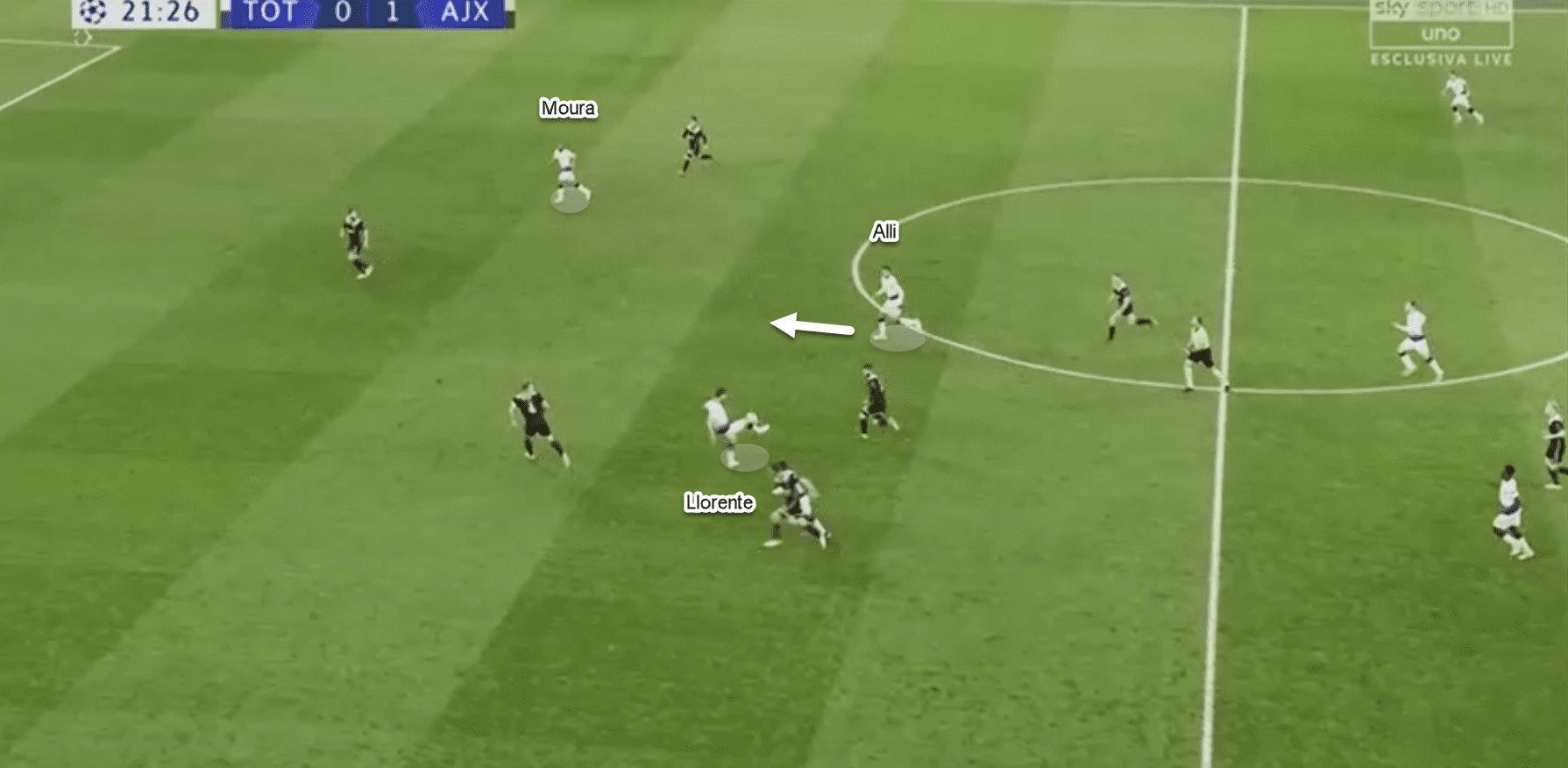
In the first leg, Spurs’ game plan was largely built around getting the ball into Llorente early in this way, and he managed to win an impressive 11 aerial duels. But in spite of his, they struggled to create any clear-cut chances. For this reason, Llorente is likely to be used only as a substitute in case Spurs need to go route one out of desperation or if they are protecting a lead and need an out-ball.
What we can expect from Ajax?
Ajax played some fantastic football in the first half and they have been rightly praised for the way they smoothly played out from the back with intricate and well executed positional interchanges. However, most of this occurred before Tottenham’s tactical switch, when they failed to apply a high press.
In the image below we see how de Jong has dropped in between the two centre backs to form a three and create a numerical advantage over Tottenham’s two strikers. But in reality their numerical advantage was much greater as the two free central midfielders were left unmarked, out of the range of Tottenham’s midfield three who had to consider any gaps they might leave in behind before getting forward to press.
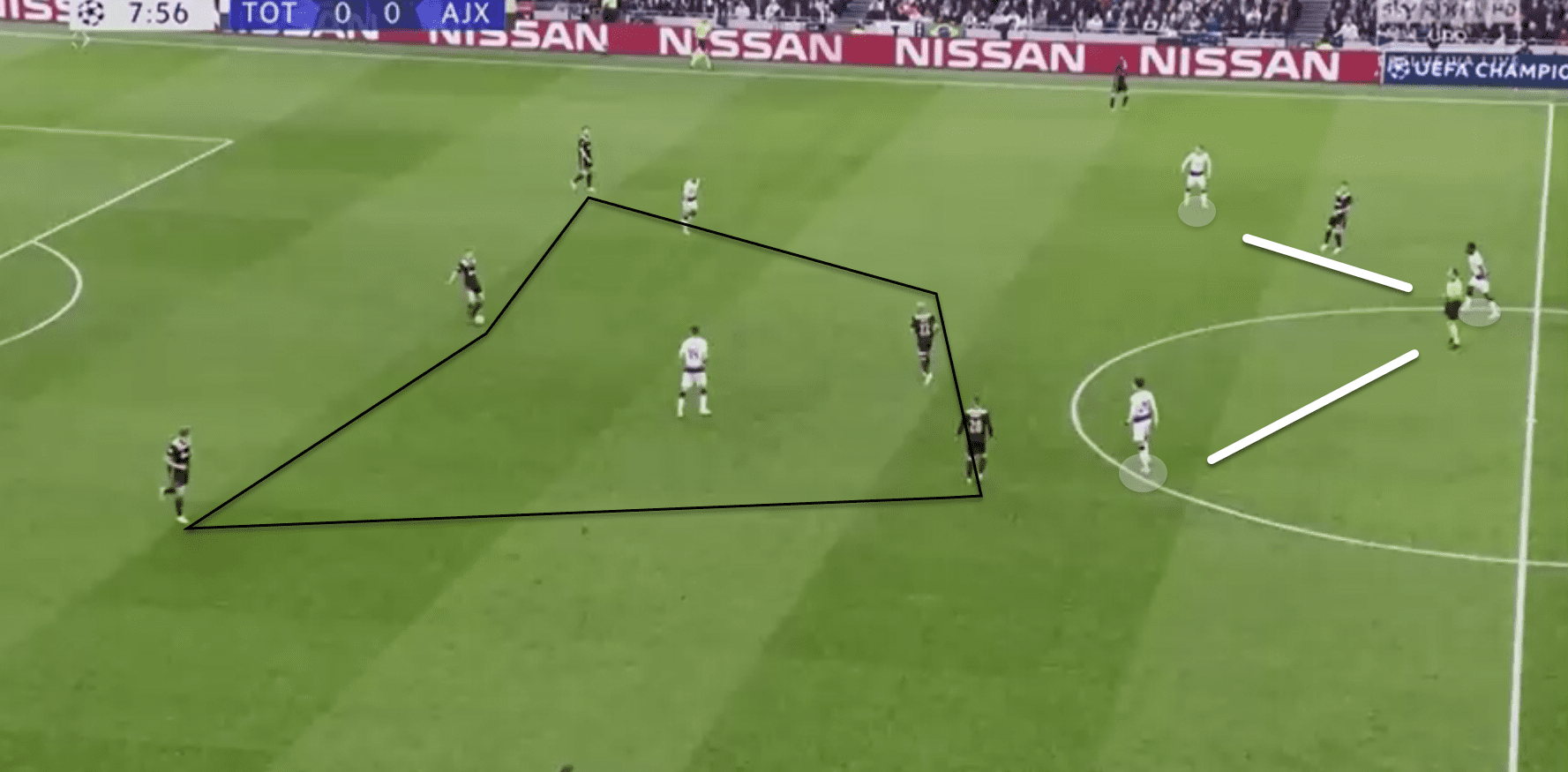
Later on in the game we saw a more pragmatic approach from Ajax, as they played long balls forward when under pressure to avoid having to play their way out of trouble. This showed us that although Ajax can play out from the back exceptionally well, their philosophy about playing out from the back is not as dogmatic as that of other sides in the recent past like Sarri’s Napoli or Guardiola’s Man City.
Ajax played a total of 80 long balls over the course of the game, 40 in the first half and 40 in the second. But what is interesting is that their success rate in the first half was 50% whereas in the second half this dropped to 28%. This suggests that a lot of the ‘long balls’ in the first half may well have in fact been long passes whereas in the second half there was more of an intention to get the ball clear to escape pressure.
This can be seen from Ajax goalkeeper Onana’s passing map from the first leg. As the game wore on, Ajax were increasingly prone to playing the ball long as opposed to passing it out to through the defenders.
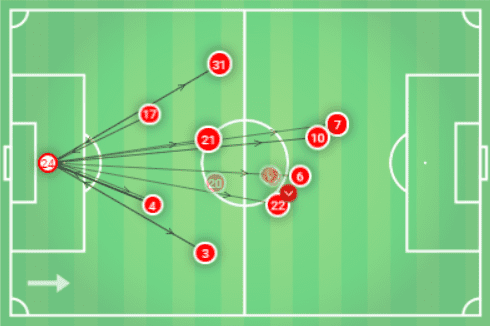
Ajax manager Erik ten Hag admitted his side’s difficulties dealing with Spurs’ direct approach in the press conference after the game:
“We didn’t anticipate well after the substitution. We weren’t able to keep the ball and that made it unnecessarily hard. We had to follow the ball too much. Tottenham chose a more opportunistic style and it took a lot of power to keep the pressure on. We would have loved to have the ball a bit more, but then we had to change our system, which would have made it easier for them to avoid the pressure.”
Judging on these quotes we might expect ten Hag to encourage his side to try to be slightly braver when it comes to keeping hold of the ball under pressure and playing through Tottenham’s press. If they can manage to do this then they will avoid having to play long balls with low chances of success: the likes of Tadić, Neres and Ziyech lack Llorente’s height and physical presence.
If they are to keep hold of the ball this way then they might be able to frustrate Tottenham, though it will be no easy task as Heung-Min Son’s agility means he will press a lot more aggressively than Llorente did in the first leg.
At the other end of the pitch Ajax will be hoping that they get more chances to press Spurs when they try to play out from the back. The home side made almost no attempts to do this in the first leg, as they had the luxury of being able to go direct to the target man in Llorente.
But if the Spaniard doesn’t start in Wednesday’s game then they may have to show a bit more cunning to play the ball along the ground in order to find pathways into the likes of Heung-Min Son and Lucas Moura. This will suit Ajax, who will concentrate on winning the ball high up the pitch in order to take advantage of any spaces that open up between Spurs’ lines.
Team news
Ajax have no new injury concerns going into the second leg so we can expect a similar line-up as last time round, though Noussair Mazraoui may be preferred to Joël Veltman at right-back.
Tottenham will most likely bring Heung-Min Son in for Fernando Llorente now that the South Korean is back from suspension. Davinson Sánchez’s injury means that Pochettino will now be forced to go with Jan Vertonghen and Toby Alderweireld as his centre-back pairing.
Serge Aurier and Erik Lamela have returned to training so should be available from the bench.
Predicted lineups
Ajax (4-2-3-1): Onana, Veltman, Blind, de Ligt, Tagliafico, de Jong, Schøne, Ziyech, van de Beek, Neres, Tadić.
Tottenham (4-2-3-1 or 4-3-1-2): Lloris, Trippier, Alderweireld, Vertonghen, Rose, Wanyama, Sissoko, Eriksen, Dele, Son, Moura.
Conclusion
This should shape up to be a very entertaining spectacle as Spurs will surely look to take the game to Ajax and press them high up the pitch through the likes of Son and Moura. For Ajax, on the other hand, it will be about maintaining their composure and staying true to their principles of passing the ball along the ground. The last thing they will want to do is be drawn into an open end-to-end goal-fest like the one that cost Manchester City so dearly in the last round.
If you love tactical analysis, then you’ll love the digital magazines from totalfootballanalysis.com – a guaranteed 100+ pages of pure tactical analysis covering topics from the Premier League, Serie A, La Liga, Bundesliga and many, many more. Buy your copy of the April issue for just ₤4.99 here, or even better sign up for a ₤50 annual membership (12 monthly issues plus the annual review) right here.

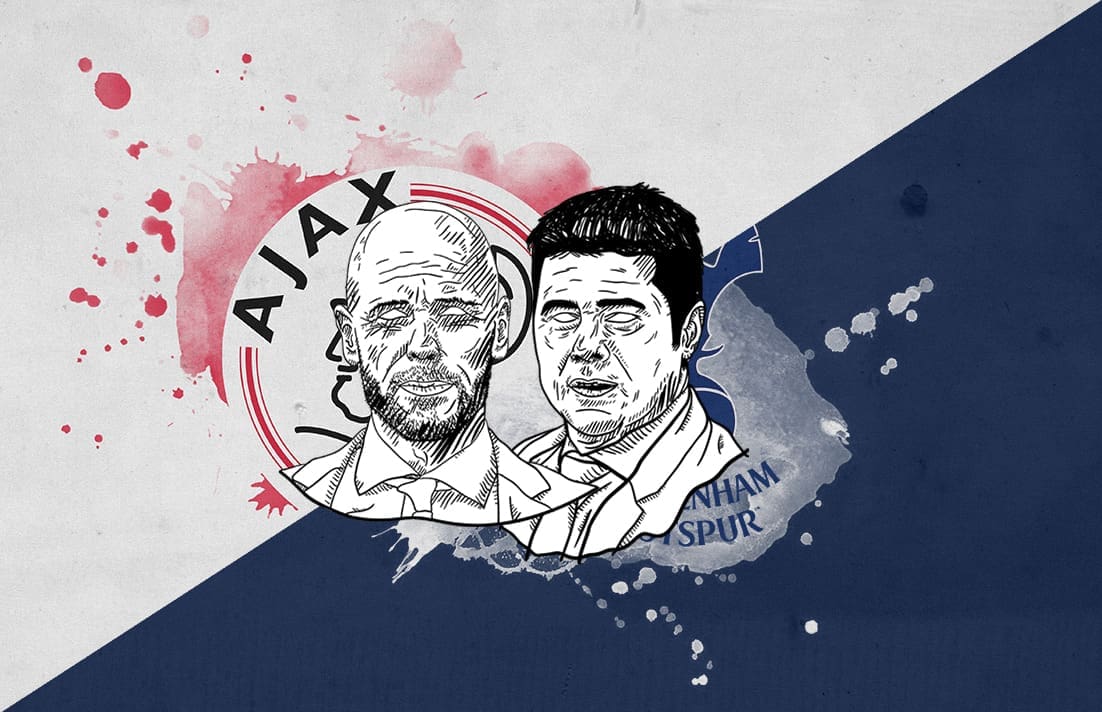


Comments